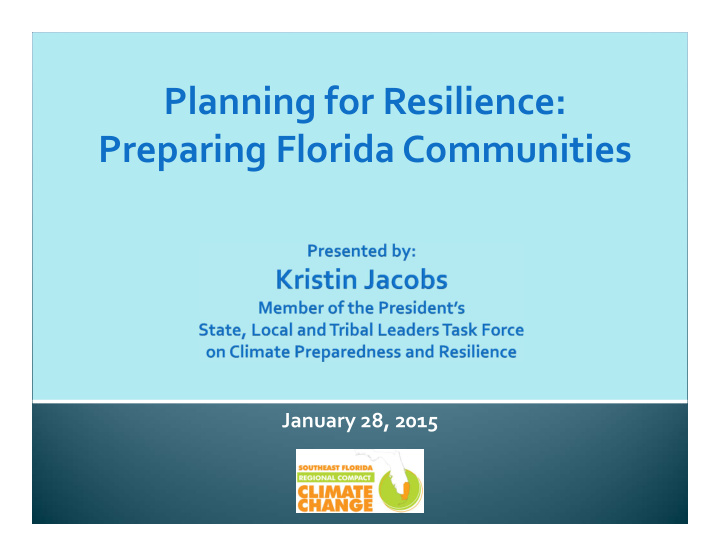



Planning for Resilience: Preparing Florida Communities January 28, 2015
• Qualities of Consequence • 4 th largest economy in US • 3 rd most populous state • 18 sea ports • Vital trade and transportation systems • Prominent service industry • Important agricultural producer • World ‐ renowned natural areas
Florida is also among the states likely hit hardest by the impacts of climate change. • Vulnerabilities and predictions include: • Severe tropical storms • Temperature extremes • Severe wet/dry seasons • Increasingly strained water supplies • Sea level rise (inland and coastal flooding) • Coastal erosion and impacts • Pressures on natural systems
Lake Lake Okeechobee, 2006 Drought Pensacola, April 2014 Fort Lauderdale, State Road A1A Palm Beach County, Tropical November 2012 Storm Isaac, August 2012
Nation ‐ wide: Extreme weather and climate impacts generated $1 billion losses in 2012, within 15 years annual costs of storm expected to average $35 billion. Florida likely to face greatest losses to coastal property from storms and tides, and public health threats associated with extreme heat Extensive critical infrastructure sits at low elevations — including roads, railways, ports, airports, and oil and gas facilities Florida projected to have $101 billion in property below mean sea level in 2030
President’s State, Local, and Tribal Leaders Task Force on Climate Preparedness and Resilience Created to advise the Administration on how the federal government can better assist local, regional, state, and tribal governments in achieving resilience, especially how to: Remove barriers and create incentives and otherwise encourage investments in resilience. Provide useful tools and information, including through intergovernmental coordination. Otherwise support state, local, and tribal preparedness for resilience to climate change.
Require consideration of climate ‐ related risks and vulnerabilities as part of all federal policies, practices, investments, and regulatory and other programs. Strengthen coordination and partnerships across federal, state, regional, local jurisdictions and economic sectors. Provide actionable data and information on climate change impacts and related tools and assistance to support decision ‐ making. Recommendations across seven themes
Reward smart land use and development decisions Promote and incentivize resiliency standards (e.g., higher building elevations) Adaptation Action Areas • Comp. plan designation • Designate areas at increased risk of flooding due to SLR, and other climate impacts • Prioritize projects and align funding
Prioritize and promote use of green and natural infrastructure Land acquisition, protection, and enhancement
Support and incentivize climate ‐ resilient water resource planning and management Reclaimed water systems Stormwater storage and reuse Integration of climate and water resource planning
Support climate resilience as part of coastal infrastructure planning and investments Regional sediment management Coastal assessments Resilient infrastructure Port Everglades Brevard County
Promote integrated watershed management to protect water quality and quantity Florida Springs Task Force at Salt Springs in 2003 (photo by T. Scott). Everglades restoration
Foster and support cross ‐ jurisdictional and regional collaborations Support delivery of down ‐ scaled data and regional projections Incentivize collaborations and leveraging of resources
Key Opportunities in 2015 Florida Land and Water Conservation Initiatives ▪ Natural floodplains, fragile coastlines, aquifer protection Water Protection and Sustainability Program • Reclaimed water, source diversification Beach Management Program ▪ Nourishment, dune Restoration, sand bypass Partnership Opportunities Water Management Districts, Department of Economic Opportunity, Florida Department of Environmental Protection, Florida Department of Transportation
Recommend
More recommend